Balbharti Maharashtra State Board Class 12 Economics Solutions Chapter 3A Demand Analysis Textbook Exercise Questions and Answers.
Maharashtra State Board Class 12 Economics Solutions Chapter 3A Demand Analysis
1. Complete the following statements:
Question 1.
The relationship between demand for a goods and price of its substitute is ……………
(a) direct
(b) inverse
(c) no effect
(d) can be direct and inverse
Answer:
(a) direct
Question 2.
The relationship between income and demand for inferior goods is …………….
(a) direct
(b) inverse
(c) no effect
(d) can be direct and inverse
Answer:
(b) inverse
![]()
Question 3.
Symbolically, the functional relationship between Demand and Price can be expressed as …………….
(a) D = f(Px)
(b) Dx = f (P2)
(c) D = f(y)
(d) D = f(T)
Answer:
(a) D = f(Px)
Question 4.
When less units are demanded at high price it shows ……………..
(a) increase in demand
(b) expansion of demand
(c) decrease in demand
(d) contraction in demand
Answer:
(d) contraction in demand
2. Give economic terms
1. A situation where more quantity is demand at lower price…………….
2. Graphical representation of demand schedule……………….
3. A commodity which can be put to several uses……………….
4. More quantity is demanded due to changes in the factors determining demand other than price…………..
5. A desire which is backed by willingness to purchase and ability to pay……………
Answers:
(1) Expansion or Extension of Demand
(2) Demand Curve
(3) Composite Demand
(4) Increase in Demand
(5) Demand
3. Distinguish between:
Question 1.
Desire and Demand
Answer:
| Desire | Demand |
| 1. Desire is a mere wish for something. For example desire for a chartered plane. | 1. Demand refers to desire backed by ability and willingness to pay for a particular commodity. |
| 2. Desire has no limits. | 2. Demand is limited by ability to pay and willingness to pay. |
| 3. Desire is not related or dependent on price. | 3. Demand is inversely related to price. |
| 4. Desire is wider in scope as it includes demand. | 4. Demand is narrow in scope as it is a part of desire. |
| 5. Example : Desire of a beggar to own a car. | 5. Example: Demand for a BMW Car by business man who has ability and willingness to pay. |
Question 2.
Expansion of demand and Contraction of demand
Answer:
| Expansion of demand | Contraction of demand |
| 1. Expansion of demand refers to a rise in demand only due to a fall in price. | 1. Contraction of demand refers to a fall in the demand due to a rise in price. |
| 2. Expansion of demand takes place solely due to falling in price. All other factors affecting demand remain constant. | 2. Contraction of demand takes place solely due to a rise in price. All other factors affecting demand remain constant. |
| 3. Expansion of demand is shown by a downward movement on the same demand curve. | 3. Contraction of demand is shown by an upward movement on the same demand curve. |
Question 3.
Increase in demand and Decrease in demand
Answer:
| Increase in Demand | Decrease in Demand |
| (a) Increase in demand refers to a rise in demand due to changes in other factors, price remaining constant. | (a) Decrease in demand refers to fall in demand due to changes in other factors, price remaining constant. |
| (b) Increase in demand occurs when more is purchased at the same price. | (b) Decrease in demand occurs when less is purchased at the same price. |
![]()
4. State with reasons whether you agree or disagree with the following statements:
Question 1.
Demand curve slopes downward from left to right.
Answer:
Yes, I agree with this statement.
Reasons justifying downwards sloping demand curve are as follows:
- The law of DiminishingMarginal Utility: Marginal utility goes on diminishing when there is increase in the stock of commodity and consumer tends to buy more when price falls and vice-versa.
- Income Effects : Whenever there is a fall in price of a commodity, purchasing power of a consumer gets increased, which enables him to buy more of that commodity.
- Substitution Effect : When price of commodity rises consumer tends to buy more of cheaper substitute goods and less of the commodity whose price has increased.
- Multi-purpose Uses : When a commodity can be used for satisfying multiple needs, its demand will rise with a fall in its price and vice-versa.
- New Consumers : When there is fall in price of a commodity, a new consumer class buy the commodity as they can afford it. Thus total demand for commodity increases with fall in price.
Question 2.
Price is the only determinant of demand.
OR
Price is the only factor that affects demand for a commodity
Answer:
No, I do not agree with the given statement. This is because there are various factors that determine demand other than price.
Reason:
The following are a few determinants:
Income of the consumer – Change in the income of the consumer also affects the market demand for goods. The effect of the change in income on the market demand depends on the type of the good.
Type of Good – The market demand for normal goods shares a positive relationship with the consumer’s income. The market demand for inferior goods (such as coarse cereals) has a negative relationship with the consumer’s income.
The market demand for Giffen goods also has a negative relationship with the income.
Consumer’s tastes and preferences – Consumers’ tastes and preferences highly influence the demand for goods. Other things being constant, if all consumers prefer a commodity over another, then the market demand for that commodity increases and vice versa.
Population size – The market demand for a commodity is also affected by the population size. Other things being equal, an increase in the population size increases the market demand for a commodity and vice-versa. This is because with the change in population size, the number of consumers in the market changes.
Question 3.
When price of Giffen goods fall, the demand for it increases.
Answer:
I Disagree with the statement.
Reason:
When price of Giffen goods falls, the demand for its decreases.
Inferior goods or low-quality goods are those goods whose demand does not rise even if their price falls. At times, demand decreases when the price of such commodities fall. Sir Robert Giffen observed this behaviour in England in relation to bread declined, people did not buy more because of an increase in their real income or purchasing power. They preferred to buy superior-good like meat. This is known as Giffen’s paradox.
![]()
5. Observe the following table and answer the following questions:
Question 1.
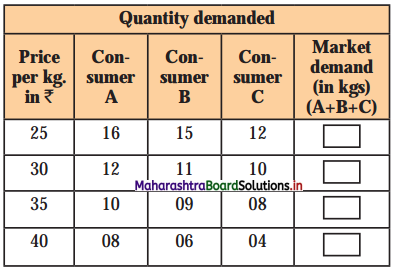
a) Complete the market demand schedule.
Answer:

b) Draw market demand carve based on above market demand schedule.
Answer:
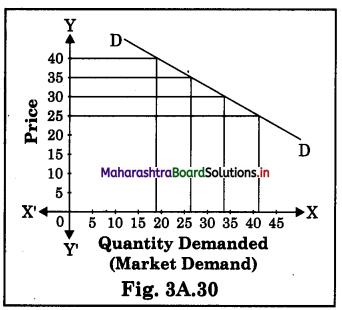
Question 2.
Observe the given diagram and answer the following questions:
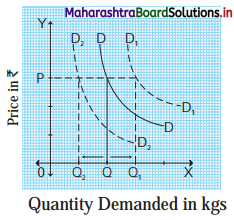
1) Rightward shift in demand curve …………….
2) Leftward shift in demand curve …………….
3) Price remains …………….
4) Increase and decrease in demand comes under …………….
Answer:
- Increase in demand (D1D1).
- Decrease in demand (D2D2).
- Constant.
- Change in demand.
Question 3.
Explain the diagrams:
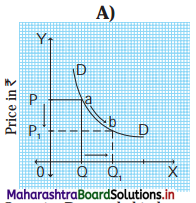
1) Diagram A represents ……………. in demand
Answer:
Expansion or Extension.
2) In diagram A movement of demand curve is in ………………… direction
Answer:
Downward.
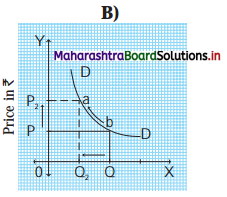
1) Diagram B represents …………………… in demand
Answer:
Constraction.
![]()
2) In diagram B movement of demand curve is in …………………… direction
Answer:
Upward.
![]()
6. Answer in detail :
Question 1.
State and explain the law of demand with exceptions.
Answer:
(A) Introduction : The law of demand is one of the important law of consumption which explain the functional relationship between price and quantity demanded of a commodity. Prof. Alfred Marshall in his book ‘Principle of Economics’ which was published in 1890, has explained the consumer’s behaviour as follows:
(B) Statement of the Law : According to Prof. Alfred Marshall, “Other things being equal, higher the price of a commodity, smaller is the quantity demanded and lower the price of a commodity, larger is the quantity demanded.
In other words, other things remaining constant, demand varies inversely with price. Marshall’s law of demand describes the functional relationship between demand and price. It can be presented as:
Dx = f(Px)
where D = Demand for Commodity
x = Commodity
f = function
Px = Price of a commodity
(C) Assumption :
- Prices of Substitute goods remain constant : The price of substitute goods should remain unchanged, as change in the price will affect the demand for the commodity.
- Prices of Complementary goods s remains constant : A change in the price j of one good will affect the demand for other, thus the prices of complementary goods should remain unchanged.
- No Expectation about future changes jj in prices: The consumers do not expect any \ significance rise or fall in the future prices.
- No change in Taxation Policy : The level of direct and indirect tax imposed by the government on the income and goods should remain constant.
- Constant Level of Income : Consumer’s income must remain unchanged because if income increases, consumer may buy more even at a higher price not following the law of demand.
- No Change in Tastes, Habits, Preference, Fashions, etc. : If the taste changes then the consumers preference will also change which will affect the demand. When commodities are out of fashion, then demand will be low even at a lower price.
(D) Explanation of the law of Demand :
The law of demand is explained with the help of the following demand schedule and diagram:
Demand Schedule
| Price of Commodity ‘X’ (in Rs.) |
Quantity Demanded of Commodity ‘X’ (in kgs) |
| 50 | 1 |
| 40 | 2 |
| 30 | 3 |
| 20 | 4 |
| 10 | 5 |
From the above demand schedule we observe that at higher price of ₹ 50 per kg, quantity demanded is 1 kg. When price fall from ₹ 50 to ₹ 40, quantity demanded rises from 1 kg to 2 kg. Similarly, at price ₹ 30 quantity demanded is 3kg and when price falls from ₹ 20 to ₹ 10 quantity demanded rises from 4 kg to 5 kg. This shows an inverse relationship between price and demand.
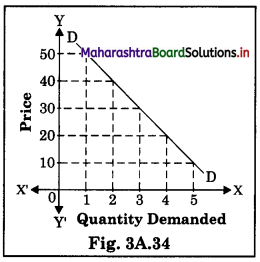
In the above diagram X-axis represent quantity demanded and Y-axis represent the price of the commodity. The demand curve DD slopes downwards from left to right ] showing an inverse relationship between price and demand. It has a negative slope.
![]()
(E) Exceptions to the Law of Demand :
No, I do not agree with this statement.
There are some important cases in which the demand for the commodity is greater when price rises and smaller when price falls. Such cases are called exceptions to the law of Demand. In such case, demand curve slopes upwards from left to right and it has a positive slope.
- Prestige Goods : Rich people buy more expensive goods like gold, diamonds, etc., even when there prices are high to maintain their status.
- Giffen Paradox : Demand for low quality goods and inferior goods decrease even if there prices falls.
According to Sir Robert Giffen when price of bread declined, people did not buy more because of increase in their real income and they prefer to buy superior goods like meat. - Speculation : People are tend to buy more commodities if they expect prices to rise further. E.g. prices of oil, sugar, etc., are expected to rise before Diwali, so people buy more of these commodities even at higher price.
- Habitual goods : Due to habit of
consumption, certain goods like tea is purchased in required quantities even at higher price. - Ignorance : Sometimes people completely ignore the price of commodity and buy more of that commodity ignoring higher price.
- Price Illusion: Consumer feels that good at higher price are of better quality, therefore demand for such goods are higher even at rise in their prices.
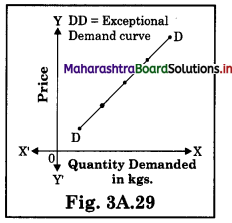
Question 2.
Explain in detail the determinants of demand.
Answer:
Meaning of Demand : Demand refers to a desire or want for goods. Desire is the willingness to have some commodity which is backed by willingness and ability to pay.
Definition : According to Benham, “The demand for anything at a given price is the amount of it, which will be bought per unit of time at that price.
Features of Demand :
- Demand is a relative concept.
- Demand is essentially expressed with reference to time and price. ?
Determinants of Demand :
- Price of Complementary Goods : Demand changes with changes in price of complementary goods like car and petrol, etc.
- Advertisement : Effective advertisement and sales promotion will lead to greater demand of product. E.g. cosmetics, toothbrush, etc.
- Price : Demand for a commodity is mainly influenced by its price. Normally at a higher price the demand is less and at a lower price it is more. Thus, demand varies inversely with price of a commodity.
- Taste, Habits and Fashions : Habits influence market demand. If people habituated to the consumption of certain goods they will not give up such habits easily. E.g. demand for liquor, cigarettes, etc. Sometimes fashion change attitude and preference of people which in turn changes market demand.
- Income: Income determines the purchasing power. Rise in income will lead to a rise in demand of a commodity and fall in income will lead to a fall in demand of a commodity.
- Other Factors : (a) Climatic condition, (b) Changes in technology, (c) Government policy, (d) Customs and traditions, etc.
- Nature of Product: Under necessary and unavailable circumstances the demand of a commodity will continue to be same irrespective of the corresponding price. E.g. medicine to control blood-pressure.
- Level of Taxation : There would be increase in price of goods and services due to high rates of taxes which results in a decrease in demand and vice-versa.
- Expectation about the Future Prices : If the consumer expect a rise in price in the near future they will demand more at present price. Similarly, when they expect price to fall, then they will buy less at present prices.
- Price of Substitute Goods : Demand for cheaper substitute goods will rise when there is fall in price of such goods. E.g. when sugar price rises, then the demand for jaggery will rise.
- Size of Population: Demand for commodity depends upon size and composition of population like age structure, gender ratio which influence demand for certain goods. E.g. larger the child population, more will be the demand for toys, chocolates, etc.
Intext Questions
Activity : (Textbook Page no. 17)
Identify the concepts :
(i) A poor person wants to have a car.
Answer:
Desire : because he does not have ability and capacity to pay the price for a car.
(ii) A rich person bought a car.
Answer:
Demand : because a rich person has a desire as well as capacity to pay a car.
![]()
Activity : (Textbook Page no. 19)
Prepare a monthly demand schedule of your family for various commodities. For example, vegetables, fruits, medicines, etc.
Answer:
[Students should do this activity by themselves]
Activity : (Textbook Page no. 19)
Complete the following hypothetical demand schedule.
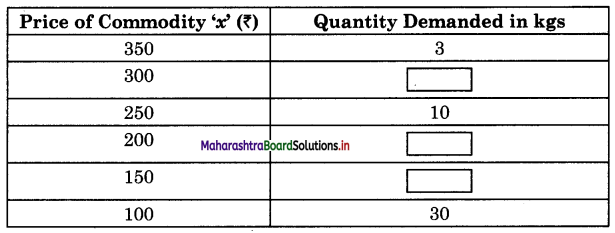
Answer:
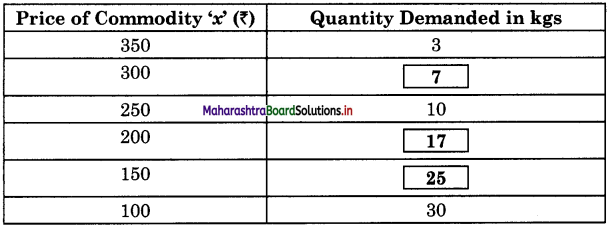
Activity : (Textbook Page no. 20)
Complete the table.
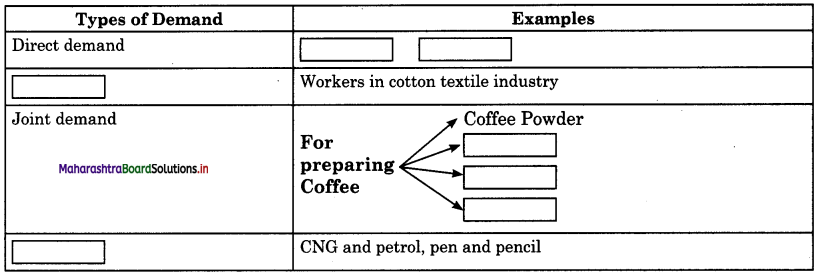

Answer:
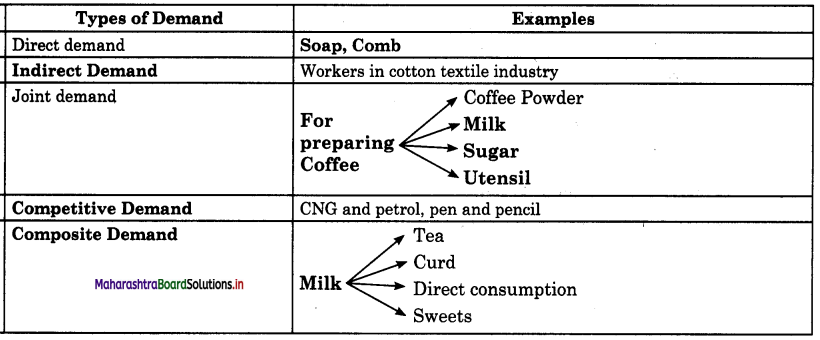
![]()
Activity : (Textbook Page no. 22)
Draw a demand curve from the following demand schedule :

Answer:
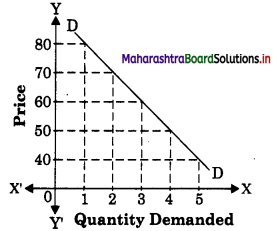
Activity : (Textbook Page no. 23)
Find out : Examples of the given exceptions to the law of demand.
(1) Prestigious Goods
Answer:
Car, Gold, Diamond, etc.
(2) Habitual Goods
Answer:
Cigarette, Tea, Drugs, Chocolates, etc.
(3) Branded Goods
Answer:
Godrej Lockers, Levis Jeans, Sony T.V, etc.